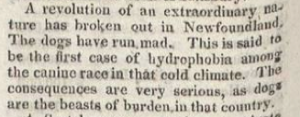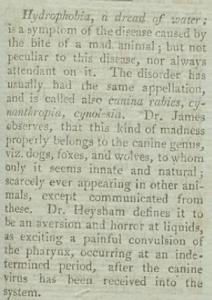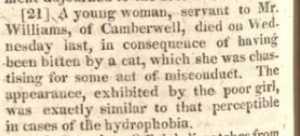It is a truth universally acknowledged – by epidemiologists, at least – that the ‘first case’ is never the first case. For example, the Duke of Richmond’s illness and death in 1819 is often said to be the first recorded case of rabies in Canada [1]. However, not only is the nature of the Duke’s illness contested, but three much more probable cases of human rabies have come to light: Charles Gigueres (dog bite, 1814), Jean Maheu (dog bite, 1816) and Madame Bruneau (cat bite, 1817) [2]. All of these reports predate the Duke of Richmond’s death.

LM, 46 (April 1815): 194. Image © Adam Matthew Digital / Birmingham Central Library. Not to be reproduced without permission
The scientific veterinary literature infers from data like these that rabies was present in Canada in pets and perhaps in wild life from at least the late eighteenth century, but the reference in the Lady’s Magazine (LM, 44 [April 1813]: 194) to the dogs running mad in Newfoundland is the first direct reference to rabies in animals in Canada of which I am aware.
The commentator reports that, ‘This is said to be the first case of hydrophobia among the canine race in that cold climate. The consequences are very serious, as dogs are the beasts of burden in that country’. It is tangentially interesting to note that the poet, Byron, owned a Newfoundland breed dog, which contracted rabies and died in 1808 at Newstead Abbey in England. The dog, ‘Boatswain’ was commemorated in a famous epitaph, the last lines of which are
BOATSWAIN, a DOG,
who was born in Newfoundland May 1803,
and died at Newstead Nov.r 18th, 1808.
Assuming that Boatswain was not a recent acquisition, he contracted rabies in Britain not Canada (the incubation period of canine rabies is usually less than 6 months; range, 10 days to about 1 year). Rabies was endemic in Britain around that time. Byron is said to have nursed Boatswain without any fear of contracting the disease himself. This may not be as fantastical as it sounds; canine rabies exists in two forms: furious and dumb. In dumb rabies the dog becomes docile and may be paralyzed. An almost contemporary (1815 case date) account of dumb rabies in a Newfoundland breed dog can be found in The Veterinarian [3]. Byron aside, by reporting the outbreak of rabies in Newfoundland in 1815, the Lady’s Magazine scored an important scientific first.
Rabies is caused by a bullet shaped Lyssavirus. Viral ecotypes emerge which become adapted to and persist in particular mammalian hosts. Nevertheless, the virus can spill over into other susceptible species. For example, canine rabies causes approximately 59,000 human deaths annually [4]. A stomach-churningly accurate description of human rabies can be found in an 1807 issue of the Lady’s Magazine (LM, 38 [March 1807]: 152–56). The average incubation period of rabies in humans is typically between one to three months (range 10 days to a year, rarely longer). Once symptoms appear, the disease in people is almost always fatal. Only 11 survivors of clinical rabies are known [5] and more than two thirds of these have lasting neurological damage.

LM, 38 (Mar 1807): 152. Image © Adam Matthew Digital / British Library. Not to be reproduced without permission
The author (Dr Motherby) of the article on ‘Hydrophobia’ extracted by the Lady’s Magazine recommended several prophylactic measures: these included immediate cautery of the bite wound, the application of a caustic substance to the wound or, preferably, excision (or amputation) of the wound site (LM, 38 [March 1807]: 156). Although Motherby offers no evidentiary basis for his recommendations they might well have worked. We must be careful here because not everyone bitten by an infectious animals contracts rabies (even in the absence of immediate action) and the risk of infection varies with the location of the bite, but well-regarded randomized controlled clinical trials from the 1960s demonstrated that immediate and thorough cleansing of the bite with soap (and some other substances) markedly reduces the risk of infection compared with controls [6], and thorough cleaning the wound is still the first of several steps in rabies prophylaxis. Dr Motherby goes on to state, that once symptoms appear, 2 grains (about 130 mg) of opium administered every 3 hours can relieve the symptoms but do ‘no more’. Other authors writing in the Lady’s Magazine were much more optimistic.
In 1816, Dr Vogelsang (of Goerlitz, in Saxony) claimed to have cured Ms Joanna Rosina of Hydrophobia by bloodletting (LM, 17 [Jan 1816]: 29). Ms Rozina ‘aged 19, had been bitten by a yard dog in the foot … Four days afterwards she found herself unwell’. Dr Vogelsang, ‘opened a vein’ and took, in all, about 38 ounces (over a litre) of blood. Ms Rozina, not surprisingly, ‘fainted away’ but subsequently was ‘quite recovered’. There are at two things that tell us this was not rabies: first, the patient recovered, and, second, the incubation period of 4 days was less than half the accepted minimum incubation period for rabies in humans (Ms Rozina was also bitten in the foot which tends to result in longer incubation periods for human rabies). According to the US Centers for Disease Control, 15 to 20% of dog bite wounds become infected and at least 40 different pathogens have isolated from dog bite wounds. If the cause of Ms Rozina’s illness was an infected bite wound (plausible, but by no means certain) there are plenty of pathogens other than the rabies virus that are better candidates.
Almost 25 years earlier than the article describing Dr Vogelsang’s apparent success, an anonymous contributor to the Lady’s Magazine (LM, 33 [June 1792]: 300) extolled the virtues of ‘Aurum palpabile’. He or she writes, ‘There are few political disorders in which it is not happily administered, as it generally performs a cure. The rabies patriotica (or patriotic fury) has often yielded to this remedy’. The contributor goes on to claim that it works even in very advanced cases of human rabies. Aurum potabile (sic) was a centuries old universal remedy: there is a laboured, jokey reference to it in Ben Johnson’s Volpone (‘Tis aurum palpabile, if it is not potabile’) and earlier mentions abound. For those interested in such things here is an eighteenth century recipe for drinkable gold (all metric measure are approximate).
Dissolve in a moderate heat half a dram (0.88 g) of fine gold, in two ounces (57 ml) of aqua regia (a mixture of nitric acid and hydrochloric acid), and add to the solution an ounce (28 ml) of the essential oil of rosemary (an infusion of rosemary in in olive oil), shake them together, and set them to rest; after which separate the oil by decantation, and add to it four ounces or five (156ml) of rectified spirit of wine (repeatedly distilled wine), digest them for a month and it will become purplish. [7]
An online search revealed that there are no randomized controlled clinical trials that demonstrate the efficacy (and more importantly, the safety) of this concoction for rabies.

LM, 44 (Dec 1813: 586. Image © Adam Matthew Digital / BritishLibrary. Not to be reproduced without permission
Rabies was endemic in Britain throughout the eighteenth and nineteenth centuries [8]. It was present in both dogs and cats. The Lady’s Magazine (LM, 14 [December 1813]: 586) reports that a servant girl in Camberwell died ‘in consequence of having been bitten by a cat, which she was chastising for some act of misconduct’. The servant died with symptoms ‘exactly similar to that perceptible in cases of the hydrophobia’.
The elimination of rabies from Britain began with various legislative acts in the second half of the nineteenth century that promoted and enforced the shooting and muzzling of stray dogs and instituted draconian quarantine laws. These laws were vigorously opposed by humane societies, but rabies disappeared (temporarily) from Britain in the first few years of the twentieth century. We do not know why. Such strategies have never worked as effectively anywhere else. It is speculated that the legislation succeeded in its aim because rabies in Britain never became endemic in foxes in Britain – fox densities were just too small to maintain the virus. It is certainly true that fox hunting in the eighteenth and nineteenth centuries resulted in such a large turnover of indigenous populations that foxes had to be imported from France to bolster the ‘thinned’ populations [9]. It would be interesting to know if contributors to the Lady’s Magazine had anything to say about foxes.
Gary Smith
Professor of Population Biology and Epidemiology
University of Pennsylvania School of Veterinary Medicine
Notes
[1] H. Tabel, A. H. Corner, W. A. Webste, C. A. Casey, ‘History and epizootiology of rabies in Canada’, Canadian Veterinary Journal 15 (1974): 271-281
[2] J. D. Blaisdell, ‘Rabies and the Governor-General of Canada’, Veterinary History 7 (1992): 19-26.
[3] Mr Youatt, (1837) ‘Animal Pathology. Rabies in the dog – symptoms continued’, The Veterinarian 10 (1837): 446-47.
[4] K. Hampson, L. Coudeville, T. Lembo, M. Sambo, A. Kieffer, M. Attlan, et al. (2015) Estimating the Global Burden of Endemic Canine Rabies. PLoS Neglected Tropical Diseases 9: 4 (2015) <e0003709. doi:10.1371/journal.pntd.0003709>
[5] M. Netravathia, V. Udanib, R. S. Manic, V. Gadada et al. ‘Unique clinical and imaging findings in a first ever documented PCR positive rabies survival patient: A case report’, Journal of Clinical Virology 70 (2015): 83–88.
[6] D. J. Dean, G. M. Baer, and W. R. Thompson, ‘Studies on the Local Treatment of Rabies-infected Wounds’, Bulletin of the World Health Organization 28 (1963): 477–486.
[7] G. Motherby, A New Medical Dictionary (London: J. Johnson, 1775).
[8] P. Muir and A. Roome, ‘Indigenous rabies in the UK’, The Lancet 365 (2005): 2175
[9] A. N. May, The Fox-Hunting Controversy, 1781-2004: Class and Cruelty (Abingdon: Routledge, 2016).
